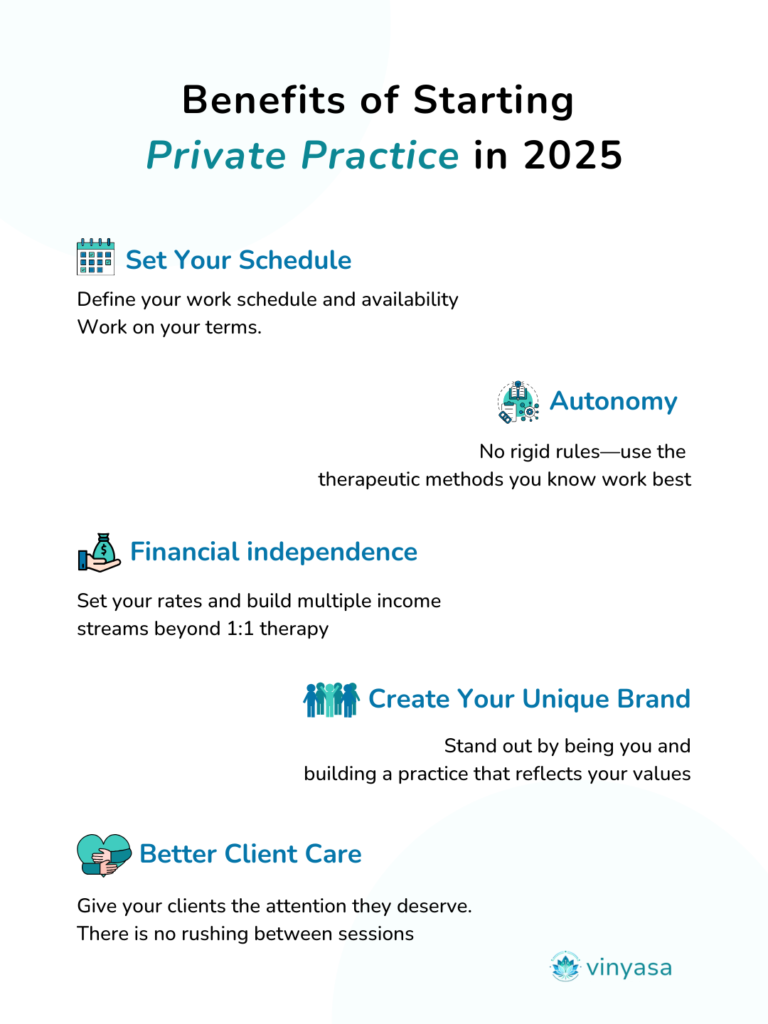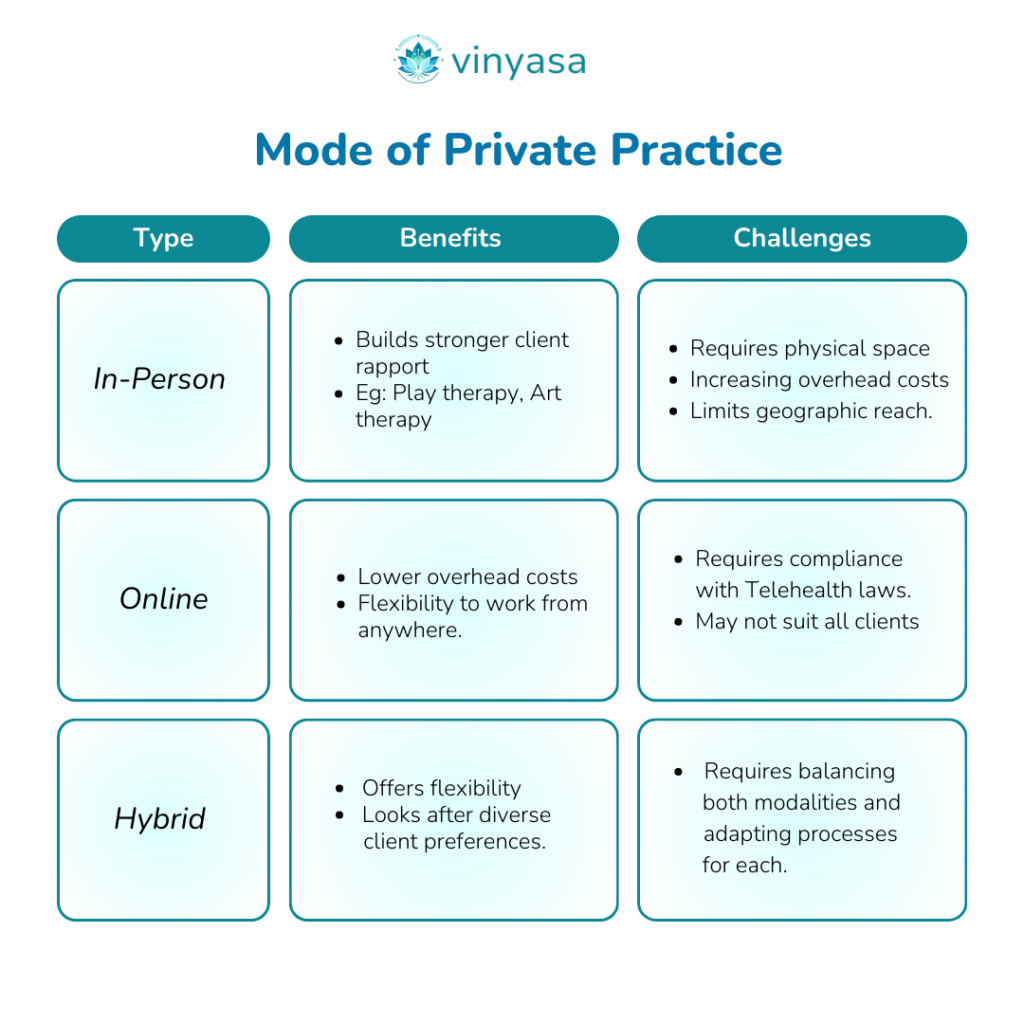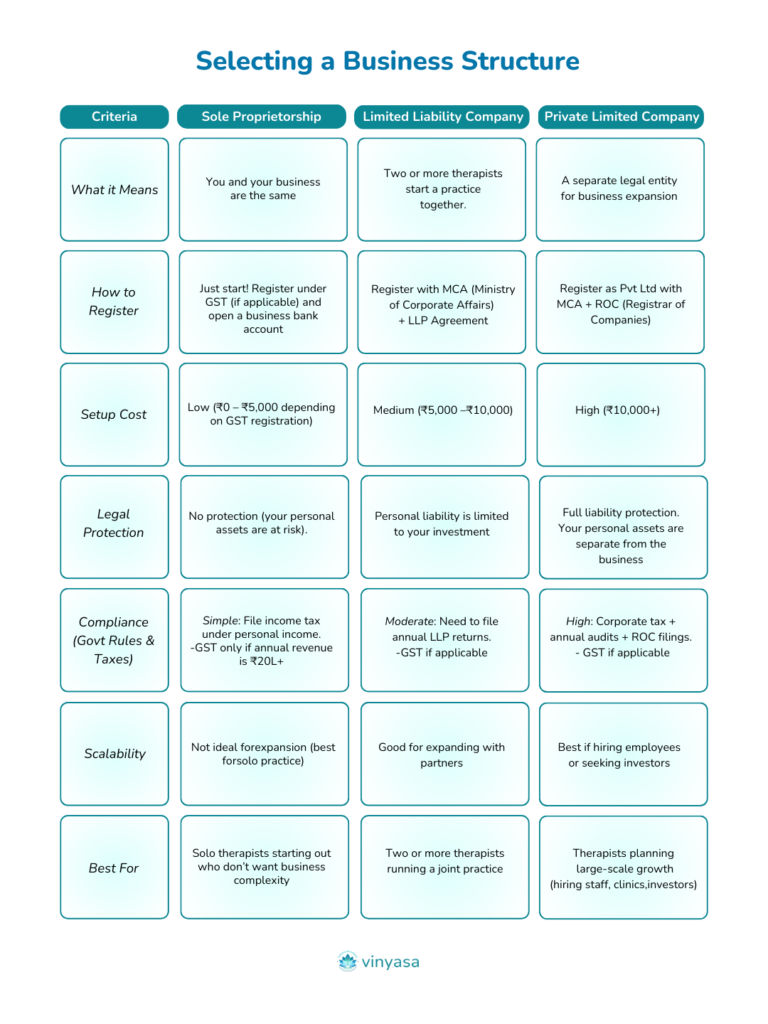The mental health industry has undergone a significant transformation in recent years. The demand for therapy has never been higher, with more individuals than ever seeking professional help. This societal shift towards embracing the importance of mental health care makes 2025 an ideal time for you to start private practice as a therapist. Why?
- Clients openly talk about mental health & seek help.
- Practice management software eliminates administrative headaches.
- Teletherapy expands your reach beyond your local area.
 This guide is designed to help you address challenges and take advantage of the opportunities in private practice. Whether you’re a therapist or starting, find actionable advice to create a sustainable and successful practice. Let’s get started!
This guide is designed to help you address challenges and take advantage of the opportunities in private practice. Whether you’re a therapist or starting, find actionable advice to create a sustainable and successful practice. Let’s get started!
Questions to Ask Before You Start Private Practice as a Therapist
Starting a private practice is a significant commitment that requires introspection. Before diving into the logistics, ask yourself:
Why do I want to start a private practice?
Your ‘why’ will serve as your anchor during challenging times. Are you seeking autonomy? Flexibility? Financial independence? Or a deeper connection with your clients? Try to be honest with yourself about what motivates you.
As Simon Sinek says — “When we know WHY we do what we do, everything falls into place. When we don’t, we have to push things into place.”
Do I have both clinical and business skills?
Running a practice isn’t just about therapy—it is also about marketing, finances, and business. Ask yourself if you have qualifications & licenses. Resilience & adaptability to manage challenges? Interpersonal skills like empathy and active listening?
If you lack skills, that’s okay. The key is to recognize gaps early and build a plan.
Does private practice align with my lifestyle goals?
Do you want to work evenings or weekends to accommodate clients? Will running your business allow you to maintain personal commitments and self-care?
Selecting the Mode of Private Practice
The mode of your practice shapes how you interact with clients and the structure of your business.

Pro Tip: Teletherapy is an excellent option for starting because it allows you to reduce costs, reach a broader client base, and provide more flexible and convenient therapy. It’s particularly beneficial for clients with mobility issues or who live in remote areas.
Choosing Your Niche as a Therapist
Identifying your niche early helps you start private practice as a therapist with clarity, making it easier to attract ideal clients.
How to Find Your Niche:
- What client populations energize me? (e.g., kids, couples, trauma survivors)
- What issues do I feel confident addressing? (e.g., anxiety, grief, career coaching)
- What type of therapy do I love doing? (CBT, EMDR, mindfulness, integrative)
Read the step-by-step guide on how to find your niche as a therapist here!
Building a Support Network (So You Don’t Burn Out)
Building a private practice can feel isolating, but you don’t have to do it alone. If you have a support group, lean on them.
- Find a mentor: Learn from experienced therapists. They can guide you through the process of starting and growing your practice.
- Join therapist communities: LinkedIn groups, professional organisations, and WhatsApp groups.
- Engage in peer supervision: Discuss cases, get feedback, and improve clinical skills.
Building a Foundation To Start Private Practice as a Therapist
1. Establish Your Business Identity
Creating a clear, compelling brand identity is crucial when you start your private practice as a therapist.
A) Name of Your Practice
A well-thought-out name builds credibility and sets the tone for your practice. Think of names like “Inner Counselling” or “Peace Therapy” that resonate with your target audience.
Avoid generic names like “Mental Health Practice”, and ensure your name is unique in your region. Look for-
- Relevance: Reflect on your niche or style (e.g., “Active Therapy” for a client-centred approach). A relevant name can attract your target audience and make your practice memorable.
- Availability: Check for domain name availability using tools like Namecheap or GoDaddy.
- Scalability: If you plan to expand, avoid using a location-specific name (e.g., “New Delhi Therapy”).
- Trademarking: Search government databases to confirm the name isn’t already trademarked.
Pro Tip: If you’re building a personal brand, use your name (e.g., “Dr. Priya Sharma Therapy”) for recognition.

Pro Tip: Consult an accountant or lawyer to choose the structure best suits your long-term goals.
C) Branding and Online Presence
- Website: Secure a website domain name early (even if you don’t build a site immediately). Platforms like Squarespace, Wix, or WordPress are good choices for beginners.
- Social Media Handles: Use consistent usernames on Instagram, Facebook, and LinkedIn, such as @InnerTherapy or @PeaceTherapy.
- Branding Elements: Design a logo, choose a colour palette, and select fonts that consistently represent your practice. Canva makes this easy.
2. Master Your Finances in Private Practice
Separating accounts and finances simplifies accounting and taxes.
- India: Provide a GST certificate (if applicable), business registration document, and your PAN card to the bank. Use UPI, direct bank transfers, or payment gateways like Razorpay, Instamojo, or PayU.
- International: Requirements vary but typically include a business license and EIN (Employer Identification Number). Stripe, PayPal, or Payoneer are reliable payment options.
Establishing a Business Phone Number and Email
- Phone: Use apps like WhatsApp Business or tools like Google Voice to maintain a professional phone number.
- Email: Set up a professional email address using platforms like Google Workspace. Example: info@yourpracticename.com.
Setting a Budget for Your Practice
- One-Time Costs: Office setup, furniture, and technology (camera, lighting for online therapy).
- Recurring Costs: Insurance, software subscriptions, marketing expenses, and rent (if in-person).
- Emergency Fund: Maintain 3–6 months of expenses to cover unforeseen challenges.
Pro Tip: Use a free budgeting tool like Excel to track expenses and income.
Calculate Session Fees
Your pricing should cover expenses while being competitive in your market. Try this calculator:
Vinyasa Health Session Fee Calculator
C) Taxes: As your income grows, consult a tax professional to identify deductions and ensure compliance. Track expenses easily to simplify reporting.
3. Legal and Compliance: Get It Right from Day One
Legal compliance is vital for protecting yourself, your clients, and your business.
A) Licensing and Registration
- India: Register with the Rehabilitation Council of India (RCI) to practice legally.
- US: Obtain a National Provider Identifier (NPI) and an Employer Identification Number (EIN) for tax purposes.
- Other Countries: Research licensing requirements for therapists in your country.
B) HIPAA & Data Protection Compliance
Protecting client data is a legal and ethical obligation. Here’s how to ensure compliance:
- Secure Communication Tools: Use encrypted email and messaging systems compliant with HIPAA. E.g., Google Workspace with HIPAA.
- Data Storage: Avoid saving client data on personal devices. Use secure, HIPAA-compliant cloud storage.
- Access Controls: Restrict access to client information and ensure strong password protocols.
Tip: Use HIPAA-compliant practice management software like Vinyasa Health to secure client data.
C) Contracts and Policies
- Regularly review contracts for clients, employees, and collaborators to ensure they align with current regulations.
- Include clear terms for payment, confidentiality, and termination.
D) Consultation and Taxes
- Hire a lawyer or accountant to ensure your contracts (e.g., client agreements and consent forms) are legally sound.
- Understand tax obligations, deductions, and filing deadlines.
Pro Tip: Schedule annual legal and financial audits to ensure compliance and identify areas for improvement.
Simplifying Private Practice as a Therapist
Streamlining your private therapy practice with the right tools.
1. Ensure Basic Supplies
- A reliable laptop. Look for good processing power to handle client sessions, documentation, and administrative tasks.
- A stable internet connection is essential for smooth online sessions and cloud-based tools. The recommended speed for video calls is 10 Mbps.
- Consider a steady power supply (UPS) or portable charger for continuous work during power outages.
2. Essential Documents for Your Private Practice
- Intake Form: Collect necessary client information before their first session.
- Consent Form: Obtain permission to provide therapy services.
- Cancellation Policy: Outline fees or procedures for missed or late-cancelled sessions.
- Payment Policy: Specify accepted payment methods, fees, and deadlines.
- Emergency Policy: Define steps for handling client emergencies.
- Booking Policy: Establish rules for scheduling, rescheduling, and session limits.
Tip: Store all forms digitally on Vinyasa to streamline your practice management.
3. Billing, Accounting, Scheduling, and Treatment Planning
Managing the administrative side of therapy can be simplified with integrated tools:
- Billing and Accounting: Tools like Excel can help track income and expenses. Razorpay offers invoicing solutions for therapists in India.
- Scheduling: Use Vinyasa Health to make seamless bookings.
- Treatment Planning: Try Google Docs or Canva templates for structured treatment plans.
- HIPAA-compliant teletherapy tools include Zoom Healthcare or Google Meet.
Learn how Vinyasa automates scheduling and reduce no shows here!
4. Manage Your Workspace
Google Workspace | Microsoft 365 |
| HIPAA-compliant when you purchase a Business or Enterprise plan and sign a BAA. | HIPAA-compliant with signed agreements for Business or Enterprise plans. |
| Includes Gmail, Google Drive, Google Meet, Google Calendar, and Docs. | Includes Outlook, OneDrive, Teams, and Word. |
5. Onboarding Clients as a Therapist
Streamline your client onboarding process. Check out our detailed blog: How to Onboard Clients as a Therapist.
Marketing Your Private Practice: Attracting Your First Clients
How will your clients know about our private practice? Try these actionable steps to help you establish a strong presence.
1. Set Up Your Online Presence
Your online presence is often the first step to making yourself visible to potential clients. Here’s how to build it effectively:
A) List Yourself on Therapy Directories: TheMindClan (India), Psychology Today, GoodTherapy, and Zocdoc.
Pro Tip: Optimise your profiles with location and niche-specific keywords like “trauma therapist in [city].”
B) Build a Simple Website: A professional website acts as your virtual office and helps convert visitors into clients. Key Pages to Include:
- Home: Showcase your services and approach.
- About: Share your story, credentials, and values.
- Services: Highlight offerings, specialisations, and session types (in-person, online).
- Blog: Publish content to address client challenges and improve search rankings.
- Contact: Include an easy-to-use form and direct booking options.
SEO Tip: Use keywords to optimise your content for search engines.
C) Set up Google My Business: Update your address, working hours, and services—request reviews from satisfied clients to build trust and credibility.
2. Social Media for Client Outreach
Choose one platform to start with. Post consistently (1–2 times weekly) and focus on your niche audience.
- LinkedIn: Ideal for networking with other professionals.
- Instagram: Great for engaging visuals, mental health tips, and reels.
- YouTube: Perfect for in-depth content like FAQs or mindfulness exercises.
3. Email Marketing
Stay connected with existing clients and nurture leads with regular newsletters. Use tools like Substack for email campaigns.
What to Share: Start with a monthly or bi-weekly schedule.
- Exclusive mental health tips and resources.
- Updates about your practice (e.g., new services, workshops).
- Upcoming events, blog highlights, or seasonal messages (e.g., “Managing Stress During the Holidays”).
Pro Tip: Use an email sign-up form on your website to grow your email list organically.
4. Content Marketing
Writing blogs and creating content can help you attract clients and establish expertise. Blogs improve your website’s search ranking. Try AI tools like ChatGPT (OpenAI), Google Gemini or Claude.
Pro Tip: Repurpose your blogs into shorter social media posts or newsletter content to maximise reach.
5. Networking and Referrals for Your Private Practice
Referrals and professional relationships are key to sustaining your practice:
- Join Therapist Communities: LinkedIn, Facebook, or WhatsApp groups for visibility.
- Build Referral Networks: Collaborate with doctors, psychiatrists, and wellness professionals.
- Join Workshops: Attend webinars and conferences to learn and build professional connections.
6. Paid Advertising (Optional)
While organic methods are often enough, paid advertising can help you scale faster:
- Google Ads: Use search ads targeting local clients (e.g., “anxiety therapist near me”).
- Social Media Ads: Instagram and Facebook ads target specific demographics.
- Budgeting: Start small (₹500–₹1,000 or $10–$20 per day) and track performance to optimise campaigns.
7. Offering Free Consultations
A short consultation can convert hesitant prospects into committed clients. It builds trust and rapport. Gives clients a sense of your therapeutic approach.
How to Structure: Limit to 15–20 minutes. Use this time to clarify client goals and explain your services.
Scaling Your Private Practice as a Therapist
As your private practice begins to thrive, it’s essential to consider growing it.
1. When and How to Expand Your Practice
Scaling your practice involves careful planning and preparation. Here’s how to determine the right time and approach:
- Market Analysis: Research demand in your area or niche. Are you consistently fully booked or turning clients away? Identify underserved populations or areas where you can expand (e.g., offering online therapy in rural locations).
- Planning for Expansion: Create a step-by-step plan that outlines your goals (e.g., increasing the number of clients, adding new services, or hiring staff). Build a financial cushion to cover the costs of scaling (e.g., marketing, hiring, or new office space).
- Ensure Resources Are Sufficient: Can you handle expansion without compromising service quality? Invest in tools and processes to streamline operations before scaling further.
2. Hiring Considerations
If you’re looking to grow your team, hiring the right people is critical. Hire when:
- You’re unable to manage the workload alone.
- Your waitlist is growing, or you want to offer specialised services you don’t currently provide.
- Administrative tasks are consuming time that is better spent on therapy.
What Roles to Consider:
- Administrative Support: Hire a virtual assistant or office manager to handle scheduling, billing, and client communication.
- Therapists or Associates: Add team members with complementary specialities to serve a broader range of clients.
- Marketing or Tech Support: Consider hiring freelancers for SEO, website updates, or social media management.
Pro Tip: Ensure contracts clearly outline expectations, payment terms, and ethical responsibilities.
3. Enhancing Client Experience
A great client experience ensures loyalty, referrals, and a positive reputation. Use Key Performance Indicators (KPIs) to track Client retention rates, session attendance, feedback scores, and average wait times.
Gather Constructive Feedback: Regularly ask clients for feedback through anonymous surveys or post-session reviews.
Managing Waitlist Clients: Offer resources like self-help guides, workshops, or short-term support while they wait.
- Maintain regular communication to show you value them.
- Consider hiring additional therapists or extending session hours temporarily to meet demand.
4. Professional Development
Continued learning is vital for staying competitive and providing high-quality care:
- Pursue advanced degrees (e.g., PhD or PsyD) to deepen your expertise or specialise further.
- Enrol in short courses to stay updated on new therapy approaches or evidence-based practices.
- Obtain certifications in high-demand areas such as trauma-focused therapy, CBT, EMDR, or couples counselling.
- Join professional associations to stay informed about trends and regulations in your field.
5. Diversifying Sources of Income
Expanding your income streams adds financial stability and allows you to serve more people:
- Workshops: Conduct stress management, parenting, and coping skills workshops. Reach a wider audience through in-person or online seminars.
- Online Courses: Create pre-recorded or live courses that address specific client needs (e.g., “Managing Anxiety in 7 Days”). Host courses on platforms like Teachable or Udemy.
- Group Therapy: Offer group sessions for common issues like grief, trauma, or relationship challenges.
Common Challenges and How to Overcome Them as a Therapist
Running a private practice comes with its own set of challenges.
 1. Managing Work-Life Balance to Avoid Burnout
1. Managing Work-Life Balance to Avoid Burnout
Wearing multiple hats can affect mental and physical well-being. Here’s how to maintain balance:
- Set Boundaries: Define precise working hours and stick to them. Maintain personal boundaries by using a separate phone or business line.
- Prioritise Self-Care: Regularly engage in activities that recharge you (e.g., hobbies, exercise, or mindfulness practices)—schedule breaks between sessions to avoid emotional fatigue. Vinyasa gives you a 15-minute breather between sessions.
Read more about essential self-care strategies for therapists here: Self-Care Blog.
2. Streamlining Your Private Practice from Day 1
Managing a private practice requires tools and processes to save time and reduce stress:
- Use Practice Management Software: Platforms like Vinyasa Health streamline admin tasks, freeing up time for therapy sessions.
- Automate Where Possible: Set up automated appointment reminders, follow-ups, and payment processing to reduce manual tasks.
3. Limited Resources
In the early stages of private practice, limited resources (time, finances, or tools) can feel overwhelming. Here’s how to optimise:
- Start with the essential step first: Building a foundation, Finances
- Try free or low-cost tools: Calendly, Canva
- Budget your finances: Up to six months
4. Dealing with Client Engagement, and Financial Uncertainties
Client No-Shows:
- Implement a cancellation policy that includes fees for late cancellations or no-shows.
- Send automated reminders via email or text 24–48 hours before sessions.
- Build rapport during the onboarding process to reduce client anxiety and uncertainty.
Client Resistance and Engagement:
- Use motivational interviewing techniques to explore and address client ambivalence.
- Regularly check in with clients about their therapy goals and progress.
Financial Uncertainties:
- To stabilise revenue, diversify income streams with workshops, group therapy, or online courses.
- Maintain an emergency fund to handle periods with fewer bookings.
5. Addressing Imposter Syndrome and Seeking Peer Support
Many therapists struggle with feelings of not being good enough, especially when starting their private practice.
- Acknowledge and Reframe Thoughts: Recognise imposter syndrome as a regular part of growth. Record the client’s positive feedback to remind yourself of your impact.
- Seek Peer Support: Discuss challenges with fellow practitioners during peer supervision. Building relationships with mentors will provide guidance and reassurance in your early journey.
- Crisis Intervention: Learn to manage crises confidently by staying updated on best practices and having a support network to consult.
6. Adjusting Marketing Strategies for Better Client Outreach
Marketing challenges are common, but with the right strategies, you can attract your ideal clients:
- Analyse What’s Not Working: Are you targeting the right audience? Is your messaging clear and aligned with your niche? Use analytics tools (e.g., Google Analytics or Instagram Insights) to assess performance.
- Experiment with New Strategies: Try new marketing approaches, such as email campaigns, video content, or collaborations with other professionals.
- Use Content to Build Trust: Create blog posts, social media content, or videos that address common client concerns, such as “What to Expect in Your First Therapy Session.”
Conclusion
Starting a private practice as a therapist is a bold step in your life. Although the journey may seem challenging initially, it empowers you with autonomy, flexibility, and the ability to make a real difference.
With the right tools, strategies, and mindset, you can navigate the complexities of building a foundation or scaling your practice.
It’s okay to start small, adjust, and learn as you go. What matters most is taking that first step. Trust yourself to grow into the therapist and business owner you aspire to be.
Your private practice is more than just a business—it’s your chance to create a lasting impact. The time to start is now.

